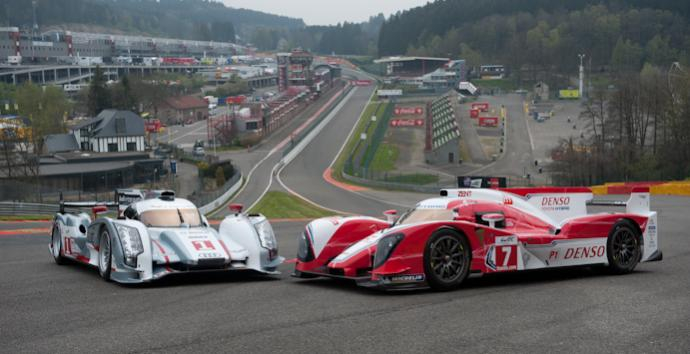

Because of the entry of hybrid cars in the Le Mans 24 Hours on 16-17 June, the Automobile Club de l’Ouest and the Fédération Internationale de l'Automobile (FIA) have decided to create specific zones where the cars in question can transmit the energy recuperated under braking. There will be seven on the 24-Hours circuit.
The hybrid systems of Audi and Toyota recover the energy generated under braking. Previously this was lost; it is now stored and transmitted under acceleration. In order to limit the size of these systems – and the budgets required for their development – the ACO and the FIA have imposed a maximum quantity of energy that can be transmitted between two braking phases: 500 kilojoules. Each hybrid car can take advantage of additional electric power without exceeding the minima laid down in the technical regulations.
In order to establish clearly-defined zones (those allowing energy (500 kj maximum) to be transmitted between two braking phases, the Automobile Club de l’Ouest and the Fédération Internationale de l’Automobile (FIA) have defined the zones where braking is sufficiently heavy to be taken into account.
There were five on the Spa-Francorchamps circuit in the second round of the FIA World Endurance Championship on 5th May 2012 in which this system was used for the first time. On the 13,629-km Le Mans circuit there will be seven (see the map).
Zone no. 1: Dunlop chicane (no. 8 marshal’s post)
Zone no. 2: Forza Motorsport Chicane (no. 42 marshals’ post)
Zone no. 3: Michelin Chicane (no. 60 marshals’ post)
Zone no. 4: Mulsanne corner (no. 76 marshals’ post)
Zone no. 5: Indianapolis Corner (no. 96 marshals’ post)
Zone no. 6: Porsche Corner (no. 115b marshals’ post)
Zone no. 7: Ford Corner (no. 131 marshals’ post)
The entry to each zone is 50 metres before the corner in question. The entrants for the Le Mans 24-Hours test day on 3rd June 2012 will have to respect these zones.
Four of the 56 cars entered for the 2012 Le Mans 24 Hours have hybrid engines: the nos 1 & 2 Audi R18 e-tron quattros and the nos 7 & 8 Toyota TS030s.
It is worth noting that in the case of Audi where the energy is fed to the front drive train the car must be running above 120 km/h for the transmission to take place. For Toyota, on the other hand, in which the energy is fed to the rear drive train there is no minimum speed.
A map will be produced for each of the circuits on the 2012 FIA World Endurance Championship calendar.
2012 Technical Regulations
Article 1.13 Energy Recovery System (LMP1 only)
Energy recovery systems are free, provided they respect the following rules:
- Recovery and release of braking energy from the brakes, either on the 2 wheels of the front axle, or on the 2 wheels of the rear axle.
- Regarding braking energy recovery, only electric systems and mechanical or electromechanical flywheel system are allowed.
- Recovery from the energy of the exhaust gases.
- Any other system recovering energy that would be lost without using it, on condition that the measurement of the released energy is possible and proved.
- The car’s minimum weight is identical to that of the other LMP1s using conventional power trains: 900 kg.
- The maximum amount of fuel allowed on board is:
* Petrol: 73 L.
* Diesel: 58 L.
- Engines must be controlled by the driver using the accelerator pedal (push to pass buttons forbidden).
- The amount of energy used between 2 braking must not exceed 0.5 MJ. Braking is a deceleration of the car greater than 2g.
Braking lasting under 1 second will not be taken into account.
If the STSY is connected to the front wheels, the release of energy is permitted only above 120 km/h.
- The current, voltage and the time of charge and discharge will be measured continuously between the energy storage system and the inverter(s).
- Equivalent sensors will be defined for the inertial systems.
- Sensors for monitoring the use of the brakes and the wheel speed will equip the car.
- Safety rules that will be imposed by the Article 15.7.
The Endurance Committee may adjust the performance of any car using such a system, should it enable the vehicle to improve its lap times in a significant manner. Competitors who want to develop and use such a system must inform the Homologation Group beforehand and provide all relevant information as to how it works, its use, the performance expected, the safety systems installed etc.
The Homologation Group must be kept informed throughout the development of the system and the car. It may demand additional information and carry out any checks it deems necessary.
To be considered as hybrid, an LMP1 car must be able to move along the whole length of the pit lane (minimum 400 m) at 60 kph using only the electric motor or the flywheel system.
The test must be carried out for the homologation of the car in the pit lane of the "24 Heures du Mans" circuit. During the test, the energy used will be measured and after the test, the weight of each element of the energy recovery system will be checked and indicated on the Homologation Form of the car. These elements must equip the car permanently and must be at the weight indicated on the Homologation Form. A new test must be carried out for any weight modification of these elements.
Photo: FRANCORCHAMPS (PROVINCE OF LIEGE, BELGIUM), CIRCUIT OF SPA-FRANCORCHAMPS, WEC 6 HOURS OF SPA-FRANCORCHAMPS, WEDNESDAY MAY 2ND 2012. A map will be produced for each of the circuits on the 2012 FIA World Endurance Championship calendar.